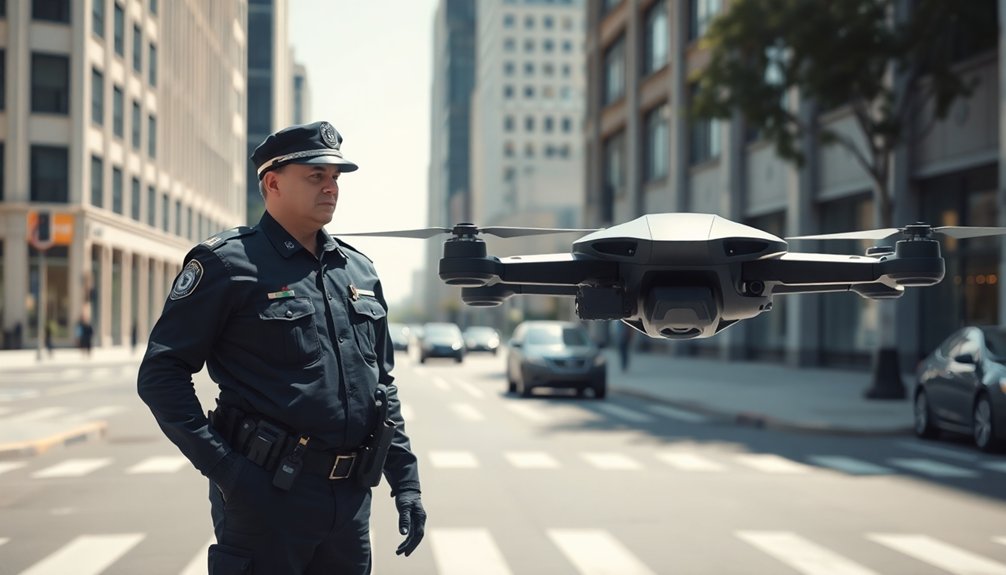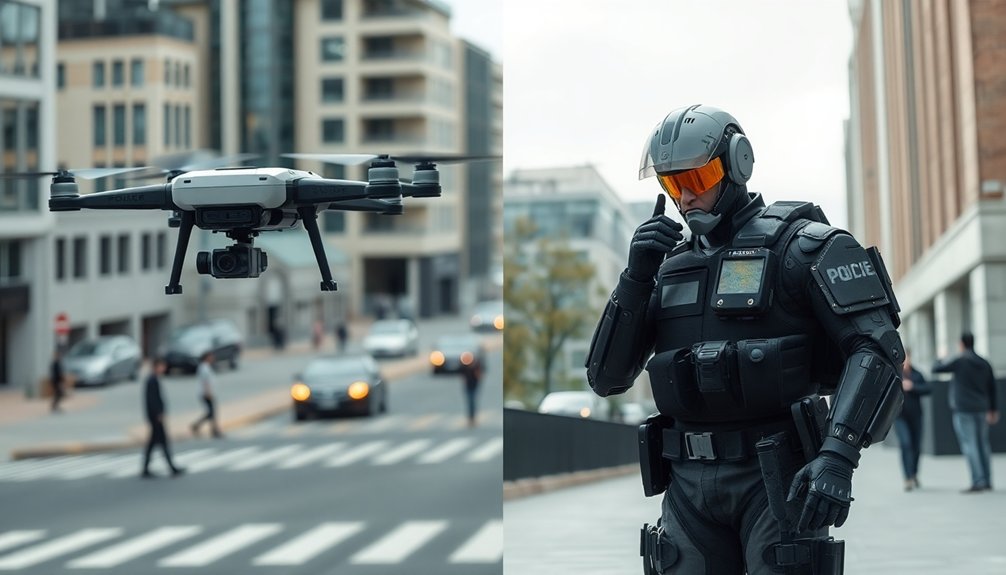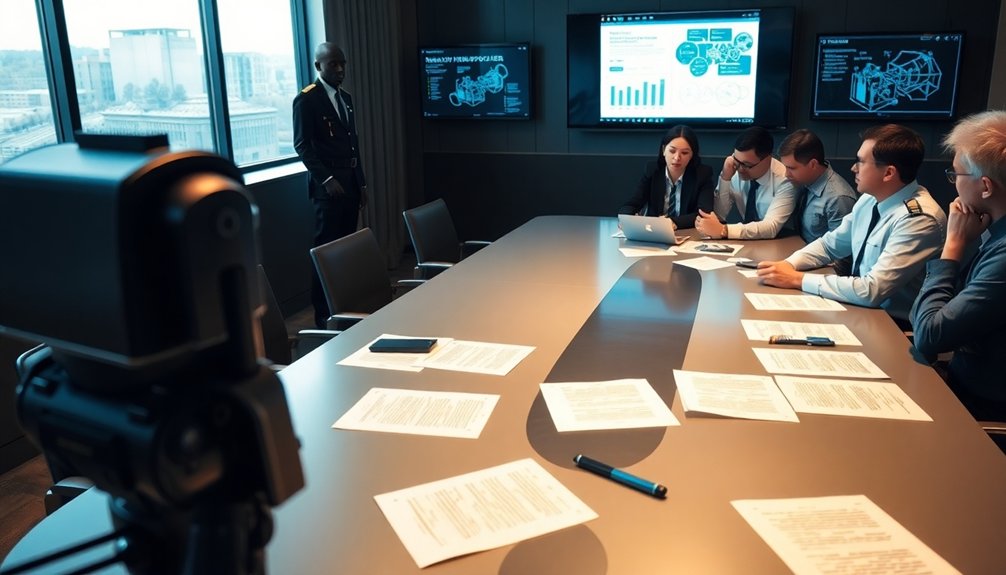Police robots aren’t just sci-fi anymore—they’re rolling down your street right now. You’ll get enhanced safety tech that can defuse bombs and surveil trouble zones, but there’s a catch. These robo-cops might accidentally target marginalized communities, misread situations, and erode your privacy. They’re cool, but not perfect. Think of them like a high-tech Swiss Army knife: useful, but you wouldn’t want it making life-or-death decisions about your neighborhood. Curious about the robot revolution?
The Rise of Robotic Law Enforcement: Technological Evolution or Ethical Minefield?

When robots first rolled onto police beats, most people thought it was something out of a sci-fi movie—not real life. Law enforcement agencies are now deploying police robots that promise enhanced surveillance and safety, but at what cost? Neuromorphic computing introduces advanced neural networks that can process sensory information with unprecedented speed and adaptability, potentially transforming robotic law enforcement capabilities. These AI systems raise serious ethical implications about accountability and community consent. Can we trust machines to make split-second decisions involving potential deadly force?
The technological evolution of robotic policing looks shiny on the surface, but underneath lies a complex landscape of potential bias and excessive force.
The militarization of police through robotic technology isn’t just about cool gadgets—it’s about fundamentally changing how law enforcement operates. Are we creating sophisticated tools or inadvertently building a surveillance state where human judgment gets replaced by cold, potentially flawed algorithms?
Advanced Capabilities: How Police Robots Transform Public Safety
Police robots aren’t just sci-fi extras anymore—they’re transforming public safety with capabilities that would make even seasoned officers do a double-take.
These high-tech guardians are reshaping law enforcement through cutting-edge advancements:
- Real-time surveillance: Advanced sensors capture everything, turning robots into walking intelligence gathering machines that never blink or get distracted.
- Bomb neutralization: Specialized robots can defuse explosives without risking human lives, turning dangerous scenarios into manageable missions.
- Continuous monitoring: Operational efficiency skyrockets when robots handle repetitive tasks, freeing human officers to engage more meaningfully with communities.
- Situational awareness: With thermal imaging and 360-degree cameras, these mechanical officers provide unprecedented insights into potential threats.
Who knew robots could be the ultimate backup team?
Welcome to the future of public safety—where technology meets protection.
Technological Benefits and Critical Challenges in Robotic Policing

While robots might sound like a cop’s ultimate sidekick, the reality of robotic policing is far more complicated than a simple tech upgrade. Advanced sensor technologies enable robots to process and interpret complex environments with unprecedented precision. Police robots promise enhanced operational efficiency, but they’re not without serious baggage. These high-tech helpers can nail surveillance and take on dangerous tasks, keeping officers safer. Yet, AI systems bring their own headaches—like potential biased identification that could unfairly target marginalized communities. Public concerns about privacy and the militarization of law enforcement add another layer of complexity. Sure, these robots can defuse bombs and patrol tricky zones, but they’re crazy expensive (think $75,000 per unit) and still need human babysitting. Community engagement isn’t just about cool tech; it’s about building trust. So, are police robots a breakthrough or just another complicated experiment in public safety?
Bias, Privacy, and Social Impact of Automated Law Enforcement
Because robots might sound like the ultimate high-tech solution to policing, they’re actually a Pandora’s box of ethical landmines.
Police robots bring serious baggage that could torpedo public trust:
- Facial recognition systems often misidentify people of color, creating dangerous bias loops in law enforcement.
- Privacy becomes a massive concern when AI-powered machines can surveil without traditional warrant constraints.
- Community engagement disappears when robotic interactions replace human connection.
- Social inequities multiply as technological implementations favor privileged demographics.
Your local police department might think robots are cutting-edge, but they’re really just automating existing systemic problems.
Transparency and accountability aren’t built-in features—they require intentional design.
Without strict ethical guidelines, these metallic officers could transform policing from potentially problematic to potentially catastrophic.
Want real public safety? Start with human understanding, not hardware.
Legal and Regulatory Frameworks for Police Robot Deployment

As autonomous law enforcement technology races ahead of legal oversight, the regulatory landscape for police robots demands immediate and nuanced attention.
You’ll need to grapple with complex legal determinations that balance technological potential against human rights. How do you define the boundaries of robotic coercive force when emotional judgment isn’t part of a machine’s programming?
The emerging regulatory framework must prioritize accountability and community approval, ensuring these humanoid officers don’t become unchecked digital enforcers. Public discussions will be critical in establishing transparent guidelines that protect citizens while leveraging technological advantages.
Robotic law enforcement demands transparent accountability, balancing technological innovation with citizen protection and ethical oversight.
Who decides when a robot can use force? What safeguards prevent algorithmic bias? These aren’t theoretical questions—they’re urgent challenges requiring collaborative solutions between technologists, legal experts, and community stakeholders.
People Also Ask About Robots
Will Robots Replace Law Enforcement?
You won’t see robots fully replacing law enforcement. They’ll continue to assist officers, handling dangerous tasks while humans maintain critical decision-making roles that require emotional intelligence and complex judgment.
What Are the Robots Used in Law Enforcement?
You’ll encounter police robots like bomb-defusing bots, surveillance K5 units, search and rescue drones, and crowd control machines. They’re designed to assist officers in high-risk situations, inspect dangerous areas, and provide public safety support.
What Situations Would a Robot Be Necessary?
You’d think humans could handle everything, right? But when bombs threaten, hostage crises unfold, or disaster zones beckon, you’ll desperately want a robot’s precision and courage to navigate risks where human lives would be tragically endangered.
Will Detectives Be Replaced by Robots?
You won’t see detectives fully replaced by robots. They’ll likely collaborate, with AI handling data analysis while human intuition and critical thinking remain essential for complex investigations and nuanced decision-making.
Why This Matters in Robotics
So, robots are coming to cop shops whether you like it or not. Did you know 68% of police departments are already exploring robotic tech? The future isn’t just knocking—it’s kicking down the door with algorithms and sensors. Will these digital deputies make us safer or turn policing into a sci-fi nightmare? The jury’s still out, but one thing’s clear: law enforcement is getting a serious technological makeover, and we’re all along for the ride.
